Blackmagic Design DeckLink 4K Extreme Service Manual
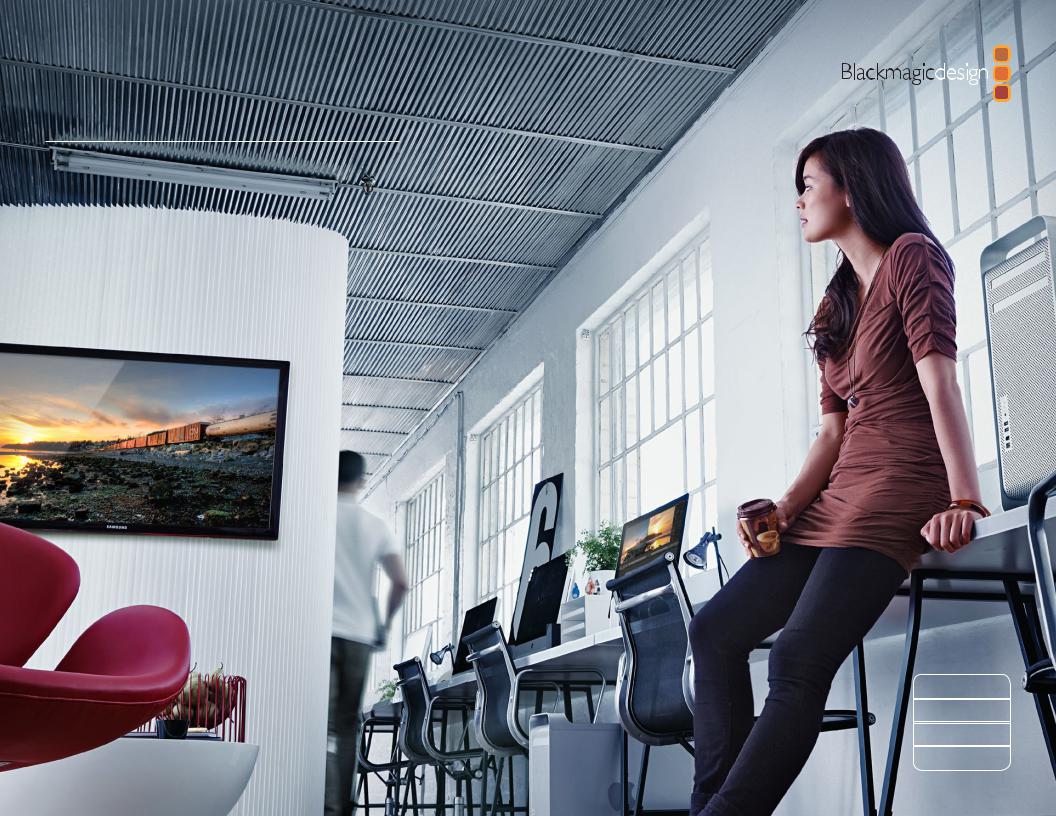
Operation Manual
Desktop Video
DeckLink, UltraStudio, Intensity
English, , Français, Deutsch, Español, , and Русский
Mac OS X™
Windows™
Linux™
September 2016
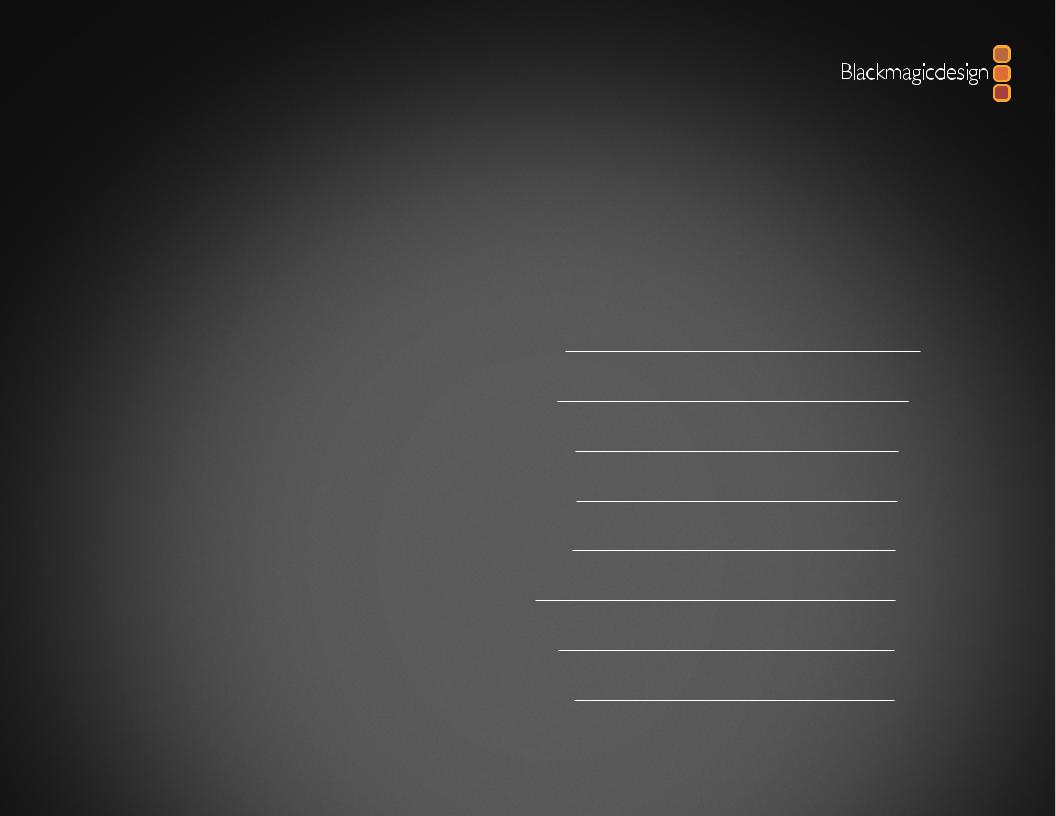
Desktop Video
English |
3 |
|
59 |
Français |
116 |
Deutsch |
173 |
Español |
230 |
|
287 |
|
344 |
|
401 |

Welcome to Desktop Video!
We hope you share our dream for the television industry to become a truly creative industry by allowing anyone to have access to the highest quality video.
Previously high end television and post production required investment in millions of dollars of hardware, however with Blackmagic Design video hardware, even Ultra HD 60p is now easily affordable. We hope you get years of use from your new UltraStudio, DeckLink or Intensity and have fun working with some of the world’s hottest television and design software!
This instruction manual should contain all the information you’ll need on installing your Blackmagic Design video hardware. If you're installing a PCI Express card, it’s always a good idea to ask a technical assistant for help if you have not installed hardware cards into computers before. As
Blackmagic Design video hardware uses uncompressed video and the data rates are quite high, you’ll need fast disk storage and a high-end computer.
We think it should take you approximately 10 minutes to complete installation. Before you install Blackmagic Design video hardware, please check our website at www.blackmagicdesign.com and click the support page to download the latest updates to this manual and Desktop Video driver software. Lastly, please register your Blackmagic
Design video hardware when downloading software updates. We would love to keep you updated on new software updates and new features. Perhaps you can even send us your latest show reel of work completed on your Blackmagic Design video hardware and any suggestions for improvements to the software. We are constantly working on new features and improvements, so we would love to hear from you!
Grant Petty
CEO Blackmagic Design

Contents
4 Desktop Video
5 |
Getting Started |
|
|
Introducing Desktop Video |
5 |
|
System Requirements |
5 |
|
Connecting Video Hardware with Thunderbolt |
6 |
|
Connecting Video Hardware with USB 3.0 |
6 |
|
Installing a Blackmagic PCIe Card |
7 |
|
Connecting External Power |
7 |
|
Connecting UltraStudio 4K Extreme with PCIe |
8 |
|
Installing the Desktop Video Software |
9 |
|
Applications, Plugins and Drivers |
9 |
|
Mac OS X Installation |
10 |
|
Windows Installation |
10 |
|
Linux Installation |
11 |
|
Capturing and Playing back Video |
12 |
13 |
H.265 Hardware Encoder |
|
|
Capturing H.265 Video with UltraStudio 4K Extreme |
13 |
14 |
Blackmagic Desktop Video Utility |
|
|
Introducing Blackmagic Desktop Video Utility |
14 |
|
Video Settings |
15 |
|
Connector Mapping for DeckLink Quad 2 |
17 |
|
Audio Settings |
19 |
|
Conversions Settings |
20 |
|
About |
22 |
23 |
DaVinci Resolve |
|
|
Live Grading with DaVinci Resolve |
23 |
|
Editing with DaVinci Resolve |
24 |
25
41
52
54
55
56
57
58
Using your Favorite 3rd Party Software
Adobe After Effects CC |
25 |
Adobe Photoshop CC |
26 |
Adobe Premiere Pro CC |
27 |
Final Cut Pro X |
30 |
Avid Media Composer |
32 |
Autodesk Smoke Extension 1 |
36 |
Blackmagic Media Express
What is Blackmagic Media Express? |
41 |
Capturing Video and Audio Files |
41 |
Capturing H.265 Video |
45 |
Playing back Video and Audio Files |
47 |
Browsing Media |
48 |
Editing Video and Audio Files to Tape |
51 |
Blackmagic Disk Speed Test
Removing the Mezzanine Card from
DeckLink 4K Extreme 12G
Help
Developer Information
Warnings
Warranty
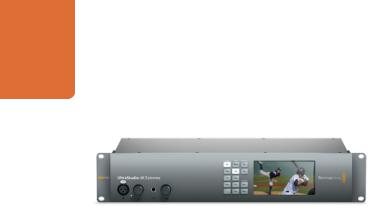
Getting Started
5 Getting Started
Introducing Desktop Video
Blackmagic Design's Desktop Video software works in conjunction with your UltraStudio, DeckLink, Intensity or Teranex hardware. The Desktop Video software includes drivers, plugins and applications like the Blackmagic Desktop Video Utility and Media Express.
This manual takes you through computer system requirements, installing hardware and software and using your favorite third party software.
System Requirements
The computer requires at least 4 GB of RAM. PCIe x1 lane cards should work in any slot. PCIe x4 lane cards require a x4 lane or faster slot. DeckLink 4K Extreme 12G requires an x8 lane or faster slot.
Mac OS X
Desktop Video software runs on the latest Mavericks and Yosemite versions of Mac OS X.
If your Blackmagic Design video hardware connects to your computer via a PCI Express slot, then a
Mac Pro with suitable PCI Express slots is required.
If your Blackmagic Design video hardware connects to your computer via Thunderbolt, then a Mac with a Thunderbolt™ port is required.
Windows
Desktop Video runs exclusively on 64-bit versions of Windows, with the latest service pack installed.
Windows 7, Windows 8 and Windows 10 are supported.
If your Blackmagic Design video hardware connects to your computer via Thunderbolt, a PC with a
Thunderbolt port is required.
Linux
Desktop Video runs on 32-bit and 64-bit x86 computers running Linux 2.6.23 or higher. Please refer to the release notes for the latest list of supported Linux distributions, package formats and software dependencies.
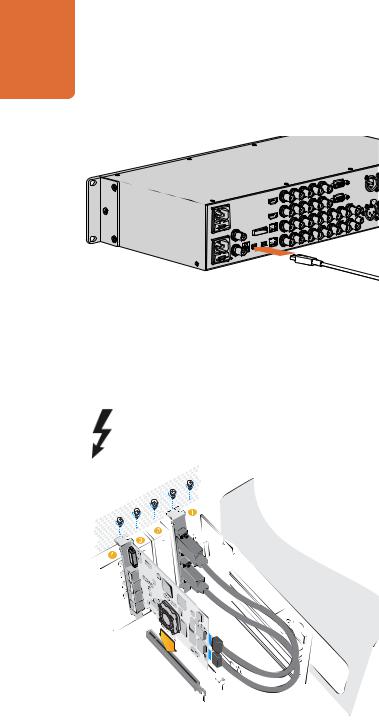
6 Getting Started
UltraStudio 4K and UltraStudio 4K Extreme feature two Thunderbolt 2™ ports so if your computer only has a single Thunderbolt port, you can use the additional port to attach a RAID or other device. UltraStudio 4K Extreme 3 has two Thunderbolt 3 ports for up to 40Gb/s data speeds. Make sure
your computer is Thunderbolt 3 compatible by looking for the Thunderbolt icon near its USB-C connector, as shown below.
Connecting Video Hardware with Thunderbolt
Step 1. If your Blackmagic Design video hardware includes an external power supply, connect it to the unit and switch on the power.
Step 2. Connect a Thunderbolt cable between the unit and a Thunderbolt port on your computer. Alternatively, you can connect to your computer's Thunderbolt disk array. UltraStudio 4K Extreme 3 has two Thunderbolt 3 connectors so you get data speeds up to 40 Gb/s.
Note: When connecting your UltraStudio 4K Extreme 3 to other Thunderbolt 3 equipment, make sure you use a 40Gb/s capable Thunderbolt 3 cable. You can easily confirm this by looking for the number '3' printed on the connector.
Step 3. If Desktop Video software has previously been installed and offers to update the internal software, click 'update' and follow any onscreen instructions. For more information about Blackmagic Design's Desktop Video software, refer to the 'Blackmagic Desktop Video Utility' section in this manual.
Step 4. If a breakout cable is supplied, connect it to the Blackmagic Design video hardware and plug the connectors into your video equipment.
Connecting Video Hardware with USB 3.0
Step 1. If your Blackmagic Design video hardware includes an external power supply, connect it to the unit and switch on the power.
Step 2. Connect a SuperSpeed USB 3.0 cable between the unit and a dedicated USB 3.0 port on your computer.
Step 3. If Desktop Video software has previously been installed and offers to update the internal software, click 'update' and follow any onscreen instructions. For more information about Blackmagic Design's Desktop Video software, refer to the 'Blackmagic Desktop Video Utility' section in this manual.
Step 4. If a breakout cable is supplied, connect it to the Blackmagic Design video hardware and plug the connectors into your video equipment.
Install a Blackmagic Design PCIe card in a spare PCIe slot. An HDMI bracket can be installed in any spare port and connects to the rear of the card with the supplied HDMI cables.
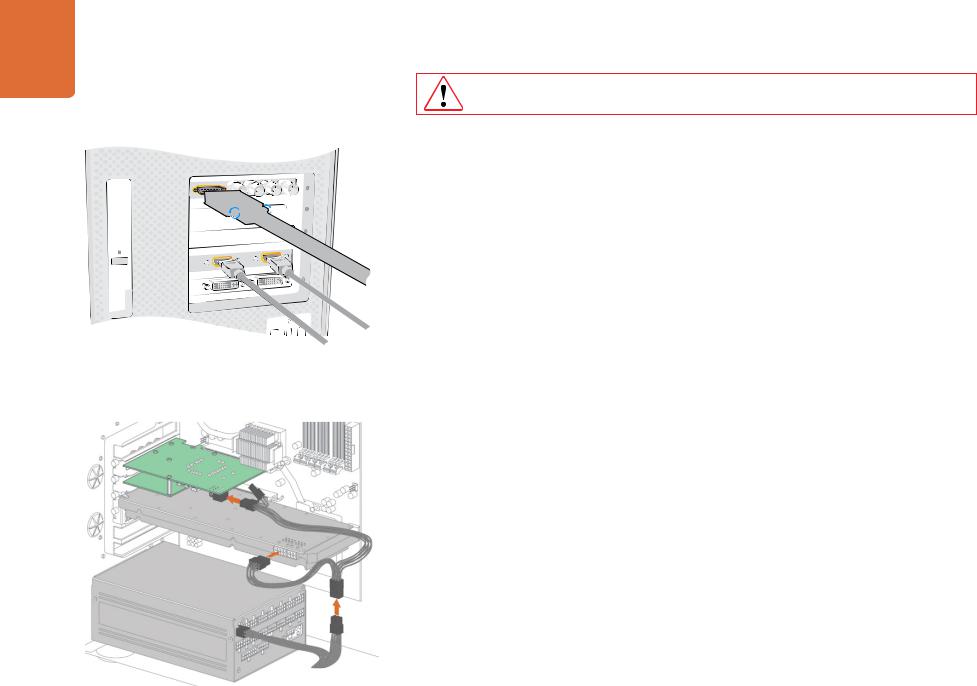
7 Getting Started
Connect the breakout cable if one is supplied with your Blackmagic Design card. Some models also include an HDMI bracket as pictured above.
If you need to supply external power to your DeckLink 4K Extreme 12G you can easily use the supplied power adapter cable. Simply disconnect the power from your graphics card and plug it into the adapter cable. The plug will only connect to one end so there's no way to connect it incorrectly.
Please be careful when installing your DeckLink PCIe card to avoid damaging delicate components on the card.
Installing a Blackmagic PCIe Card
Step 1. Remove the power plug from your computer and ensure that you are statically discharged.
Step 2. Carefully align your Blackmagic Design PCIe card with an appropriate PCIe slot in your computer and push firmly into place.
Step 3. If your Blackmagic Design PCIe card includes an HDMI bracket, insert the bracket into a spare slot. Secure the PCIe card and HDMI bracket with screws, loop the HDMI cables around any other installed cards and plug them into the rear of the DeckLink card.
If you need to connect external power to your Decklink 4K Extreme 12G, refer to the 'connecting external power' section in this manual for instructions.
Step 4. Replace the cover of your computer, connect any supplied breakout cables and switch it on.
Step 5. If Desktop Video software has previously been installed and offers to update the internal software, click 'update' and follow any onscreen instructions. For more information about Blackmagic's Desktop Video software, refer to the 'Blackmagic Desktop Video Utility' section in this manual.
Connecting External Power
DeckLink 4K Extreme 12G operates at extremely high speeds and may require more power than is available from a PCI Express slot. If you need to supply external power to your DeckLink 4K Extreme 12G you can easily use the supplied power adapter cable.
To connect power to your DeckLink 4K Extreme 12G:
Step 1. Remove the power plug from your computer and ensure you are statically discharged.
Step 2. Remove the side panel from your computer and check to see if your computer's power supply unit has a spare power cable. If so, you can connect it directly to your DeckLink card.
Step 3. If you have a powered graphics card that's already using any spare cables from the power supply, you will need to use the supplied Y shaped adapter cable to send power to both your graphics card and DeckLink card. Simply disconnect the power from your graphics card and plug it into the adapter cable. The plug will only connect to one end so there's no way to connect it incorrectly.
Step 4. Now plug one of the two Y connectors into your graphics card and the other into your DeckLink card. The connectors are 6 and 8 pin compatible. You should now have power supplied to both your graphics card and DeckLink card.
Step 5. Secure the side panel to your computer and reconnect power.

8 Getting Started
UltraStudio 4K Extreme features a PCIe port for connection to an external PCIe adapter card that is installed in
your computer.
The PCIe adapter card is inserted into a PCIe slot inside your computer.
Connecting UltraStudio 4K Extreme with PCIe
UltraStudio 4K Extreme 3 requires a PCIe Gen 3 slot if you want to connect via PCIe. We have built a PCIe Gen 3 adapter card for this purpose. The Blackmagic PCIe Cable Kit is available at your nearest Blackmagic Design reseller.
To connect the original UltraStudio 4K Extreme to your computer's PCIe Gen 2 slot, you can use the Blackmagic PCIe Cable Kit or purchase a standard PCIe adapter card from your nearest computer store.
To install a PCIe adapter card:
Step 1. Remove the power plug from your computer and ensure that you are statically discharged.
Step 2. Carefully align the PCIe adapter card with the appropriate PCIe Gen 2 or Gen 3 slot in your computer and push firmly into place. Secure the PCIe adapter card bracket with screws.
Note: It's important to mention that UltraStudio 4K Extreme 3 requires a PCIe Gen 3 slot.
Step 3. Replace the cover of your computer and connect the supplied PCIe extension cable from your computer to the PCIe port of your UltraStudio 4K Extreme.
Step 4. Connect the power cable to your UltraStudio 4K Extreme to power it up and then switch on your computer.
Step 5. If Desktop Video software has previously been installed and offers to update the internal software, click 'update' and follow any onscreen instructions. For more information about Blackmagic Design's Desktop Video software, refer to the 'Blackmagic Desktop Video Utility' section in this manual.
The supplied extension cable is connected to the PCIe port located at the back of your computer.

9 Getting Started
Installing the Desktop Video Software
Applications, Plugins and Drivers
The table below lists the applications, plugins and drivers that are included when you install the
Desktop Video software.
Mac OS X
Blackmagic Desktop Video drivers
Blackmagic Desktop Video Utility
Blackmagic Design LiveKey
Blackmagic Media Express
Blackmagic QuickTime™ codecs
Blackmagic Disk Speed Test
Adobe Premiere Pro CC, After Effects CC, Photoshop CC presets and plug-ins
Final Cut Pro X plug-ins
Avid Media Composer plug-in
Windows |
Linux |
Blackmagic Desktop Video |
Blackmagic Desktop Video |
drivers |
drivers |
Blackmagic Desktop |
Blackmagic Desktop |
Video Utility |
Video Utility |
Blackmagic Design LiveKey |
Blackmagic Media Express |
Blackmagic Media Express |
Blackmagic AVI codecs |
Blackmagic AVI and |
|
QuickTime™ codecs |
|
Blackmagic Disk Speed Test |
|
Adobe Premiere Pro CC, After |
|
Effects CC, Photoshop CC |
|
presets and plug-ins |
|
Avid Media Composer plug-in |
|
|
|
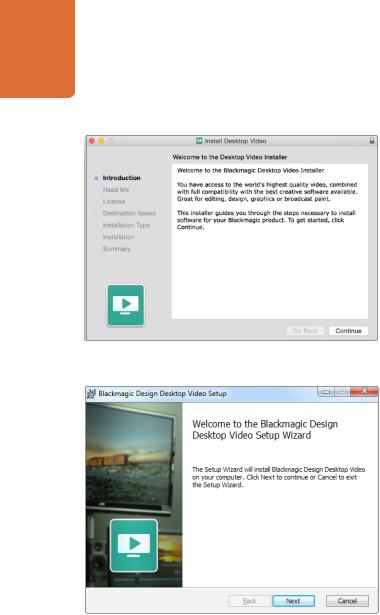
10 Getting Started
replace pic
Desktop Video Installer for Mac
Desktop Video Installer for Windows
Mac OS X Installation
Make sure you have administrator privileges before installing any software.
Step 1. Ensure you have the very latest driver. Visit www.blackmagicdesign.com/support
Step 2. Launch the Desktop Video Installer from the media included with your hardware or from a downloaded disk image.
Step 3. Click the 'continue', 'agree' and 'install' buttons to install the software.
Step 4. Restart your computer to enable the new software drivers.
Automatic Updates
When your Mac restarts the software will check the internal software version of your hardware. If the internal software version does not match the driver version, you will be prompted to update the internal software. Click OK to start the update and restart your Mac to complete the process.
Windows Installation
Step 1. Ensure you have the very latest driver. Visit www.blackmagicdesign.com/support
Step 2. Open the “Desktop Video” folder and launch the “Desktop Video” installer.
Step 3. The drivers will now be installed on your system. An alert will appear: “Do you want to allow the following program to install software on this computer?” Click 'yes' to continue.
Step 4. You will see a dialog bubble saying “found new hardware” and the hardware wizard will appear. Select “install automatically” and the system will find the required Desktop Video drivers.
If you have a DeckLink Quad 2 installed in a Windows 7 computer, Windows Update will attempt to check each driver in case a newer version is available. In this particular case it is unnecessary as all drivers in the latest Desktop Video release are the most recent. You can temporarily disable the feature by clicking on the notification and then clicking “Skip obtaining driver software from Windows Update”. Confirm the action by clicking ‘yes’. The installation will now be a lot faster.
Step 5. After all drivers have been installed, a dialog bubble will appear saying “your new hardware is ready for use.” Restart your computer to enable the new software drivers.
Automatic Updates
When your computer restarts the software will check the internal software version of your hardware. If the internal software version does not match the driver version, you will be prompted to update the internal software. Click OK to start the update and restart your computer to complete the process.

11 Getting Started
Desktop Video software ready to be installed from the Ubuntu Software Center.
Linux Installation
Step 1. Download the latest Desktop Video software for Linux from www.blackmagicdesign.com/support
Step 2. Open the Desktop Video folder and navigate to the packages required for your distribution and architecture. Note that 'amd64' refers to Intel and AMD 64-bit processors. There are three sets of packages provided:
The desktopvideo package provides the core drivers and API libraries.
The desktopvideo-gui package provides the Desktop Video Utility software.The mediaexpress package provides a simple capture and playback utility.
Step 3. Double click the packages you wish to install and follow the onscreen instructions. If you see any messages about missing dependencies, ensure they are installed first and then rerun the Desktop Video installer.
Step 4. When the installer has finished it is recommended that you restart your computer to complete the installation process.
If you cannot find a native Desktop Video package for your Linux distribution, or if you prefer to install from a command line, refer to the ReadMe file for detailed installation instructions.
Updates
If you have installed the graphical utilities, you will be automatically notified when you need to update the internal software. When your computer restarts, the software will check the internal software version of your hardware. If the internal software version does not match the driver version, you will be prompted to update the internal software. Click 'ok' to start the update and restart your computer to complete the process.
If you have not installed the graphical utilities, you can check the internal software is up to date using the BlackmagicFirmwareUpdater command line tool:
# BlackmagicFirmwareUpdater status
A message similar to the following will appear:
0: |
/dev/blackmagic/io0 [DeckLink SDI 4K] 0x73 OK |
1: |
/dev/blackmagic/io1 [DeckLink 4K Extreme 12G] 0x0A PLEASE_UPDATE |
In this case you could update the internal software with the following command:
# BlackmagicFirmwareUpdater update 1
See the 'man' page for a more detailed description of the command’s usage. e.g., for more info on the internal software updater command, type “man BlackmagicFirmwareUpdater”.

12 Getting Started
Camera Outputs
HDTV
Connect a video monitor and source to your Blackmagic Design video hardware.
Click the 'capture' button to commence recording.
Capturing and Playing back Video
It's a good idea to run a quick test to ensure you can successfully capture and play back video.
Setting-Up
Step 1. Connect a monitor or TV to the video output of your Blackmagic Design hardware.
Step 2. Connect a video source to the input of your Blackmagic Design hardware.
Testing Video Capture
Step 1. Launch Blackmagic Media Express. Click on the 'log and capture' tab. Your input video format is automatically detected and Media Express sets the project video format to match. Your video source will appear in the Media Express preview pane.
Step 2. Click 'capture' at the bottom of the 'log and capture' window to perform the capture test. Click 'capture' again to finish the test. The captured clip is added to the media list on the left side of Media Express.
Testing Video Playback
Step 1. Click on the 'playback' tab.
Step 2. Double-click the test clip. The video and any present audio will be sent to the monitor connected to your hardware's output.
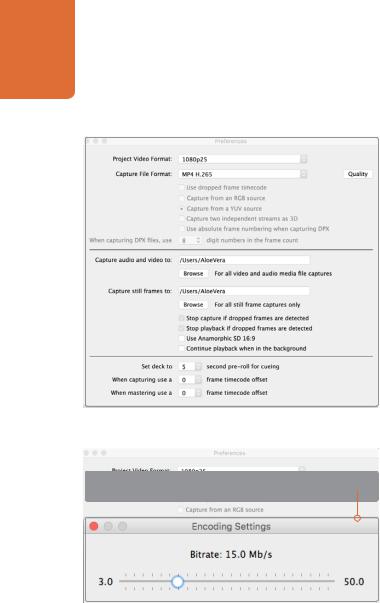
H.265 Hardware Encoder
13 H.265 Hardware Encoder
To capture H.265 video using Blackmagic UltraStudio 4K Extreme, set the capture file format in Media Express preferences to MP4 H.265.
Set the bitrate for H.265 capture by clicking on the ‘quality’ button and dragging the ‘encoding settings’ slider
left or right.
Capturing H.265 Video with UltraStudio 4K Extreme
Blackmagic UltraStudio 4K Extreme has a powerful built in H.265 hardware encoder that lets you capture the latest H.265 video in real time. This gives you the ability to capture video using encoding technology that maintains stunning video quality at the lowest possible bitrate.
To capture video using the built in H.265 encoder:
Step 1. Launch the Blackmagic Media Express software. Open Media Express ‘preferences’ and set the ‘capture file format’ to MP4 H.265.
Step 2. Set the bitrate for your H.265 capture by clicking on the ‘quality’ button located next to the H.265 setting and dragging the ‘encoding settings’ slider left or right. Close the ‘encoding settings’ window to confirm your setting. Your Blackmagic UltraStudio 4K Extreme is now ready to encode H.265 video using Blackmagic Media Express. For information about how to capture and play back video using Media Express, refer to the ‘Blackmagic Media Express’ section of this manual.
Setting the Bitrate
The default bitrate is set to 15 Mb/s which is a good choice for high quality Ultra HD video that is streamed online, but you can set it anywhere between 3 to 50 Mb/s. For online streaming of HD video, a good choice is between 3 to 5 Mb/s.
Drag the 'encoding settings' slider to the left if you need to capture video with a smaller file size and a lower bitrate, or drag to the right if file sizes are not an issue and you want the best possible video quality. Setting the bitrate too low will result in compression artifacts in your picture, such as visible macro-blocking, pixelation or banding. However, the H.265 hardware encoder is very efficient and keeps artifacts to a minimum, so you can set the bitrate lower than you normally would for H.264 video and still retain great video quality.
When encoding H.265 video, or any type of video encoding for online streaming, it’s often helpful to consider a few things, such as the bandwidth of your intended delivery system, the amount of movement and contrast between frames in your video, and the frame rate of your video. For example, if there is a large number of people streaming your video, you may need to lower the bitrate in your encoding so audience members with slower internet connections can watch without download interruptions. Higher bitrates are better for video content with lots of contrast and movement between frames, such as bright to dark, or high energy sporting events and graphics. Video with high frame rates also require higher bitrates compared to video at lower frame rates.
Choosing a bitrate for your encoding can often be an experimental process to achieve the best video quality in the smallest file size, so it’s worth testing a variety of bitrate settings for the best results.
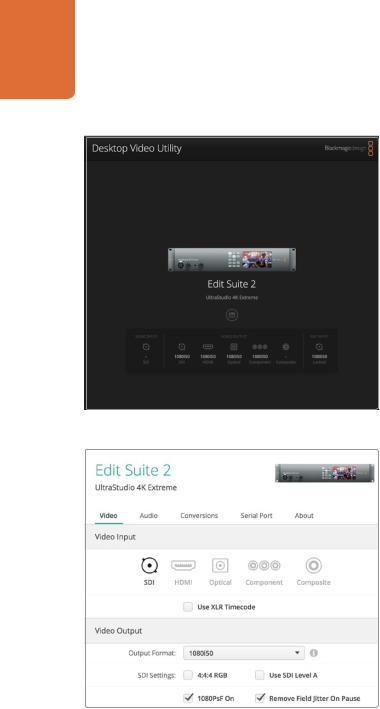
Blackmagic Desktop Video Utility
14 Blackmagic Desktop Video Utility
Blackmagic Desktop Video Utility home page.
Blackmagic Desktop Video Utility lets you adjust video and audio input and output settings, apply up or down conversions during capture and playback, and provides information about the driver.
Introducing Blackmagic Desktop Video Utility
Blackmagic Desktop Video Utility provides a central location for configuring hardware settings, plus a realtime status display showing the video connected to your hardware's inputs and outputs.
To launch Blackmagic Desktop Video Utility:
On Mac OS X, click Blackmagic Desktop Video in 'system preferences' or you can launch the utility from your 'applications' folder.
On Windows 7, click the 'start' button>all programs>Blackmagic Design>Desktop Video and click the Desktop Video utility application. The Desktop Video utility also launches from the Windows 7 ‘control panel’.
On Windows 8, from the 'start' page type 'Blackmagic' and then click the Blackmagic Desktop Video Utility application. The Desktop Video utility also launches from the Windows 8 ‘control panel’.
On Windows 10, click the 'start' button>all programs>Blackmagic Design>Desktop Video and click the Desktop Video Utility application. The Desktop Video utility also launches from the Windows 10 'control panel'.
On Linux, go to 'applications' and then 'sound and video' and double-click the Blackmagic Desktop Video Utility application.
When you first open Blackmagic Desktop Video Utility, the home page displays your connected hardware and provides an overview of all video activity on your hardware’s input and output connections. If you are sending a video signal to your input, it will be automatically detected and the format will be displayed under the Video Input icon.
If you have multiple Blackmagic capture and playback devices connected, you can cycle through them by clicking the arrow buttons on the sides of the home page. To configure settings, simply click on the hardware image, or the settings icon located below the hardware name. The Desktop Video utility only displays the settings that are relevant to your selected hardware, so you don't have to scroll through pages of menus to find the settings you want.
The following pages of this manual will show you how to adjust settings using Blackmagic Desktop Video Utility.

15 Blackmagic Desktop Video Utility
Click on an icon to set your video input connection.
Video Settings
Video Input
Click on a connector icon to set the 'video input' connection for your Blackmagic Design hardware. Only the connectors that are built into your hardware will be shown. When a valid video signal is detected, the input and video format will be displayed on the Blackmagic Desktop Video Utility home page.
Enable the checkbox to capture timecode from the dedicated XLR input.
Drag the sliders to adjust chroma and luminance levels on analog video.
Set the output format to match your Final Cut Pro X project.
Use the SDI Settings to control the output of your SDI video.
Choose whether to output via single link, dual link or quad link for 3G, 6G and 12G-SDI video signals.
Use XLR Timecode
Select this setting to read timecode from the XLR input instead of the SDI stream.
Analog Video Input Levels
Drag the ‘video’ and ‘chroma’ sliders to adjust the analog video input levels for component or composite video. Dragging the video slider affects the luma gain and the chroma sliders decrease or increase the color saturation. When using component video, you can adjust the Cb and Cr values independently. Click the ‘link’ icon to connect them if you want to adjust them simultaneously.
Video Output
To use broadcast monitoring with Final Cut Pro X, set the output format to match your Final Cut Pro X project.
SDI Settings: Includes adjustments to control the SDI video signal.
1080PsF On: Enable the checkbox to output progressive segmented frame video.
Remove Field Jitter On Pause: Enable the checkbox to eliminate field flicker when interlaced video is paused on old CRT monitors. It is not recommended for modern flat screens.
4:4:4 RGB: Enable the checkbox to output 4:4:4 RGB video.
Use SDI Level A: Enable the checkbox to output 3Gb/s SDI signals as SMPTE Level A direct mapping. If the box is unchecked, 3Gb/s signals will be sent with Level B mapping. This only affects the output as SDI Level A and Level B mapping is autodetected on input.
SDI Configuration: Select between single link, dual link and quad link for 3G, 6G or 12G-SDI output. Some professional color grading monitors and projectors only accept high bandwidth signals like 2160p60 or DCI 4K 4:4:4 via quad link. UltraStudio 4K Extreme can output quad link 3G-SDI and you can also get a Quad SDI add on card for DeckLink 4K Extreme 12G.
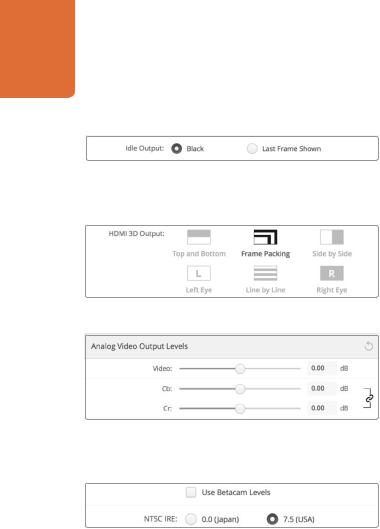
16 Blackmagic Desktop Video Utility
Set Analog Video Output
'Idle output' sets what is displayed on the video output when video is not being played. You can choose to output black, or the last frame shown during playback.
Click on an icon to set your HDMI 3D Output format.
Adjust the video slider to set composite analog video output levels, and the Cb and Cr sliders for controlling color balance when using component video.
Enable the 'use Betacam levels' checkbox when working with Sony Betacam SP decks. Select the relevant NTSC IRE level when using an NTSC composite video format.
If your Blackmagic Design hardware has shared analog video connectors, you can choose whether to output your video via 'component', 'composite' or 's-video' by selecting between the 'analog video output’ options.
Idle Output: Use this setting to choose what is displayed on the video output when video is not being played.
Black: Sends black frames to your outputs.
Last Frame Shown: Outputs the last frame of the video clip or sequence last played.
HDMI 3D Output: This setting determines the 3D format for your HDMI monitoring.
Frame Packing: combines left and right eye images into a single frame without compression.Line by Line: the left and right eye images are carried on alternate video lines without
compression.
Left Eye: only the left eye image is displayed.
Right Eye: only the right eye image is displayed.
Side by Side: arranges both left and the right eye images horizontally with 50% compression.Top and Bottom: arranges both left and right eye images vertically with 50% compression.
Analog Video Output Levels
Drag the 'video' and 'chroma' sliders to adjust the analog video output levels for component or composite video. Dragging the video slider affects the luma gain and the chroma sliders decrease or increase the color saturation. When using component video, you can adjust the Cb and Cr values independently. Click the 'link' icon to connect them if you want to adjust them simultaneously.
Use Betacam Levels: Blackmagic Design products use SMPTE component analog levels to maintain compatibility with most modern video equipment. Enable the checkbox if working with Sony Betacam SP decks.
NTSC IRE: Select the 7.5 IRE setup for the NTSC composite video used in the USA and other countries. Select the 0 IRE setup if you’re working in Japan or countries that don’t use the 7.5 IRE setup. PAL and high definition formats do not use this setting.
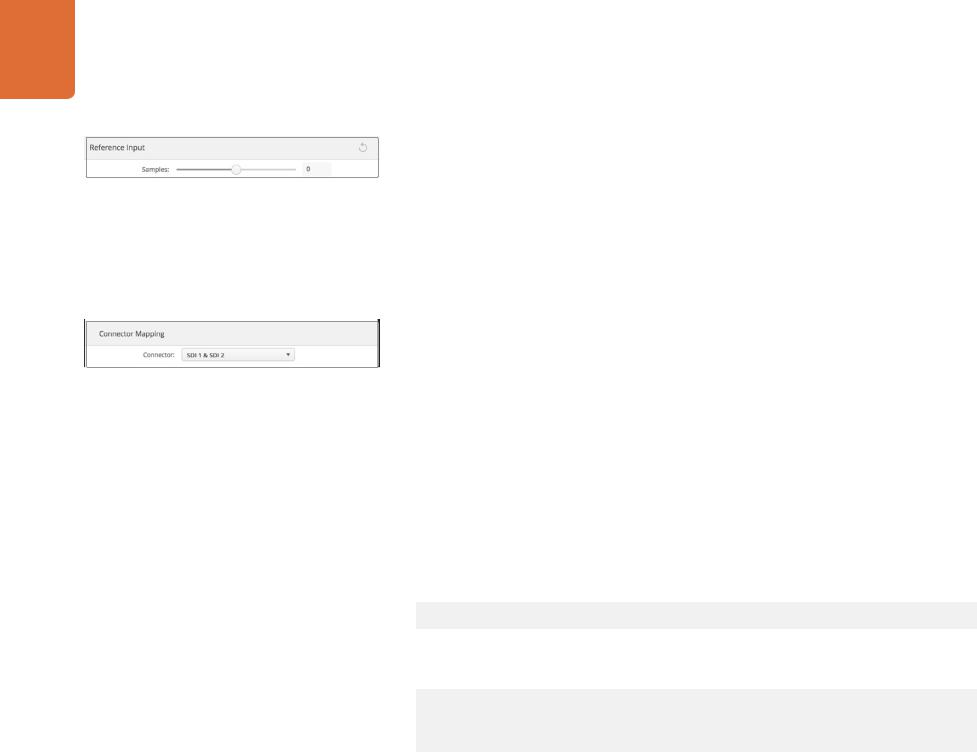
17 Blackmagic Desktop Video Utility
If locking to a reference, adjust this setting to time the video output relative to the reference input.
Reference Input
The reference adjustment lets you adjust the timing of the video outputs of your hardware relative to the video reference input. This is commonly used in large broadcast facilities where the video output needs to be accurately timed. The reference adjustment is in samples so you can get an extremely accurate timing adjustment down to the sample level.
A common example of how this setting would be used is where all the hardware in your facility has a stable common reference connected and then all the devices would have the timing set so the video outputs all match perfectly. This would then make it possible to switch between devices on a downstream router or production switcher and would eliminate any glitching when switching.
If you have a DeckLink Quad 2 installed, the 'connector mapping' setting lets you assign SDI connectors to each DeckLink Quad device.
Connector Mapping for DeckLink Quad 2
If you have a DeckLink Quad 2 installed in your computer, you can input or output SDI signals over 8 independent mini BNC connectors. This gives you the ability to capture or play back 8 separate video streams, similar to having 8 capture and playback devices in one single product. This is why your DeckLink Quad 2 appears in Desktop Video Utility as 8 individual DeckLink Quad devices which makes it easier to configure your inputs and outputs. You can even name each device so you can keep track of which DeckLink Quad device is being used for a specific video signal.
SDI connectors can be mapped to each device using the ‘connector mapping’ settings in the Desktop Video utility, but it’s important to know that specific connectors are dedicated to specific devices. For example, SDI 1 is dedicated to DeckLink Quad (1), and SDI 2 is dedicated to DeckLink Quad (1) and DeckLink Quad (5).
It’s easy to see which SDI connectors are dedicated to each DeckLink Quad device by looking at the table below, where you can also check the mapping options for them.
Mapping Options
DeckLink Quad Devices |
Dedicated SDI Connectors |
|
SDI 1 and 2 |
DeckLink Quad (1) |
or |
|
SDI 1 |
|
SDI 3 and 4 |
DeckLink Quad (2) |
or |
|
SDI 3 |
|
|
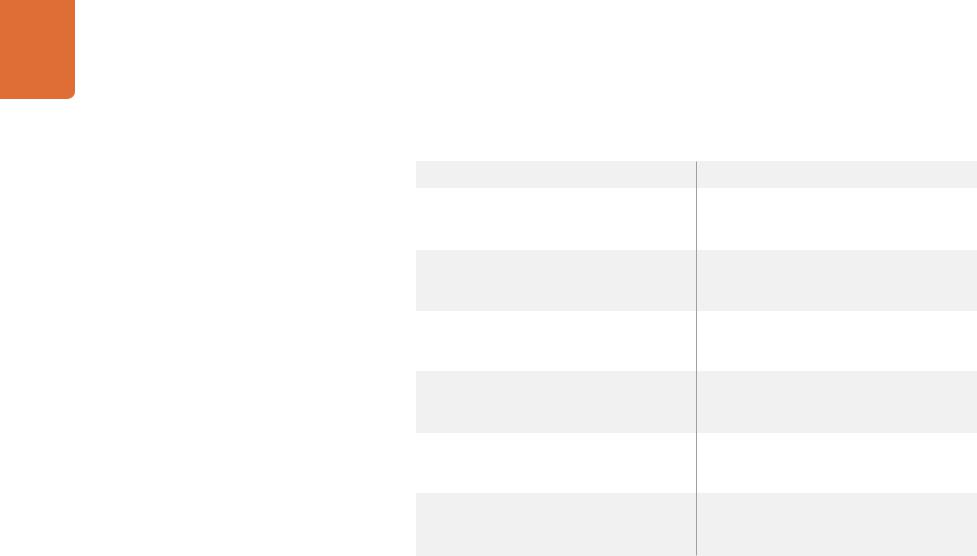
18 Blackmagic Desktop Video Utility
Mapping Options continued
DeckLink Quad Devices
DeckLink Quad (3)
DeckLink Quad (4)
DeckLink Quad (5)
DeckLink Quad (6)
DeckLink Quad (7)
DeckLink Quad (8)
Dedicated SDI Connectors
SDI 5 and 6 or
SDI 5
SDI 7 and 8 or
SDI 7
SDI 2 or none SDI 4 or none SDI 6 or none SDI 8 or none
It’s worth mentioning that when configuring an SDI connector for a specific device, it will also affect the device sharing that connector. For example, if DeckLink Quad (1) is set to use SDI 1 and 2, DeckLink Quad 5 will automatically be set to ‘none’ because its shared SDI connector is being used. Alternatively, if you select SDI 2 on DeckLink Quad (5), DeckLink Quad (1) will automatically be set to SDI 1. For this reason, it’s important to note which SDI inputs or outputs are being used by each device to avoid accidentally interrupting the input or output of another device.
If you have an original DeckLink Quad installed in your facility and are using a custom designed SDK application, you can be confident that installing DeckLink Quad 2 will work in your system without having to make any changes to your application. Additional mapping features in your DeckLink Quad 2 will allow you to build on your existing system to provide even more input and output configurations if you need them.

19 Blackmagic Desktop Video Utility
Click on a connector icon to set your 'audio input' connection.
Drag the ‘output level’ slider to control your AES/EBU digital output level.
Adjust the input channel sliders to control your analog audio input levels. Enable the 'use HiFi audio levels' checkbox if connecting consumer audio equipment.
Drag the 'input level' slider to control your microphone input level.
Adjust the output channel sliders to control your analog audio output levels.
Audio Settings
Audio Input
Click on a connector icon to set your 'audio input' connection for your Blackmagic Design hardware. You can select from the following inputs:
Embedded: includes audio channels as part of video signals. SDI and HDMI are capable of carrying embedded audio.
AES/EBU: is a digital audio signal that can carry 2 audio channels over a single connector.XLR: is a three pin audio connector that is predominantly used by professional analog
audio equipment.
RCA or HIFI: is a connector used to connect unbalanced analog audio to and from consumer audio equipment, such as HiFi systems, DVD players and televisions.
Microphone: Phantom power supplies power through microphone cables and is a convenient power source for condenser microphones.
Enable the 'use +48V phantom power' option if your microphone requires phantom power. If you’re unsure whether your mic needs phantom power or not, it’s best to leave this box unchecked as there is a risk of causing damage to microphones that are self powered. An LED on the front of UltraStudio 4K Extreme will illuminate when phantom power is active. Be sure to wait at least 10 seconds for phantom power to discharge after disconnecting before plugging in a self powered microphone. Older ribbon type microphones and dynamic microphones are not suitable for phantom power usage.
AES/EBU
Drag the sliders to adjust the 'ref' level, or gain, for the AES/EBU audio inputs and outputs. Press the reset icon to reset the gain to 0 dB.
Analog Audio Input Levels
Channel 1/Channel 2: These settings adjust the gain for the analog audio inputs when capturing. Click the ‘link’ icon to adjust them simultaneously.
Use HiFi Audio Levels: Professional XLR connectors are standard on UltraStudio and DeckLink models. If you want to connect consumer audio equipment to the XLR connectors, make sure you enable the 'use HiFi audio levels' checkbox as the audio levels between professional and consumer equipment differ. You'll also need to use an RCA to XLR adapter.
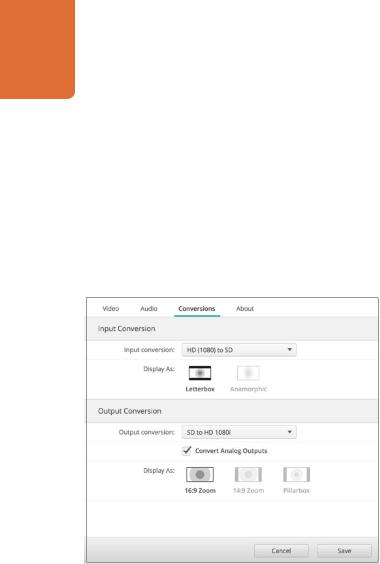
20 Blackmagic Desktop Video Utility
Analog Audio Output Levels
Channel 1/Channel 2: These settings adjust the strength of the audio signal, or gain, for the analog audio outputs while playing back video. Click the ‘link’ icon to adjust them simultaneously.
Reset Icon
When adjusting sliders, you may want to cancel your change. The reset icon is the circular arrow located at the right of each settings' title bar. Press the reset icon in each setting to restore the gain sliders to 0 dB.
Conversions Settings
To set your up or down conversion settings, select your input or output conversion from the respective dropdown menu, and click on the desired aspect ratio selection. Remember to click 'save' to apply your settings.
Input Conversion
This setting enables realtime up and down conversion during capture. Select your desired conversion from the 'input conversion' dropdown menu.
Input conversion results in up to a 2 frame delay, so you'll need to adjust your editing software's timecode offset to ensure frame accuracy.
Display As: Select how you'd like your converted video presented. Depending on your input video's original aspect ratio, options may include letterbox, anamorphic, center cut, pillarbox, 16:9 zoom or 14:9 zoom.
Output Conversion
This setting enables realtime up and down conversion during playback. Select your desired conversion from the dropdown menu.
Output conversion results in up to a 2 frame delay, so you'll need to adjust your editing software's timecode offset to ensure frame accuracy.
Convert Analog Outputs: Enable this checkbox to also perform your conversion on the analog video outputs.
Display As: Select how you'd like your converted video presented. Depending on your video's original aspect ratio, options may include letterbox, anamorphic, center cut, pillarbox, 16:9 zoom or 14:9 zoom.
The following table outlines the different aspect ratio selections available during conversions.
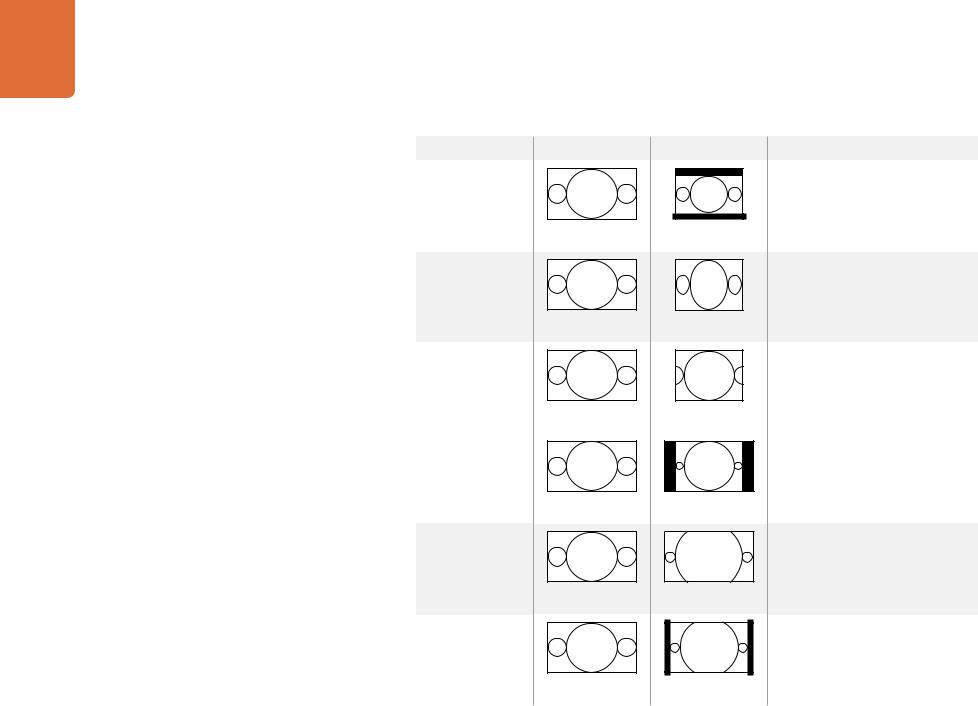
21 Blackmagic Desktop Video Utility
Down Conversion |
Source Image |
Converted Image |
Letterbox |
|
Scales the entire 16:9 HD image |
|
|
into a 4:3 SD frame leaving black |
|
|
bars on the top and bottom. |
Anamorphic |
|
Horizontally squeezes the 16:9 HD |
|
|
image into a 4:3 SD frame. |
Center Cut |
|
This setting cuts a 4:3 SD frame from |
|
|
the 16:9 HD image. This aspect ratio |
|
|
setting discards a portion from |
|
|
each side of the 16:9 image. |
Pillarbox |
|
Displays a 4:3 SD image inside an |
|
|
16:9 HD frame. Black bars feature |
|
|
on the sides. |
16:9 Zoom |
|
Scales the 4:3 SD image to fill the |
|
|
16:9 HD frame. |
14:9 Zoom |
|
A compromise between Pillarbox |
|
|
and 16:9 Zoom. Minimal black bars |
|
|
with slight crop top and bottom. |
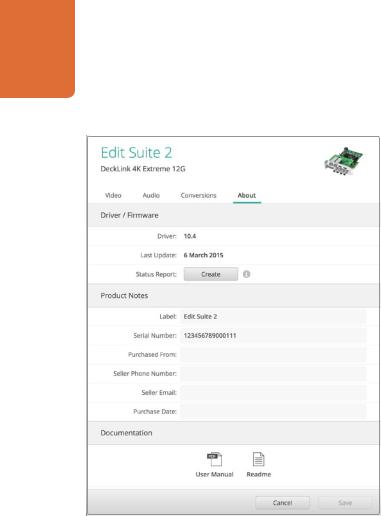
22 Blackmagic Desktop Video Utility
The ‘about’ section provides valuable information such as the driver version, user manual and release notes. You can also generate a status report and enter product notes specific to your hardware.
About
Driver
The 'about' page in Blackmagic Desktop Video Utility provides information about your hardware's current driver, and the last time your hardware was updated.
You can also generate a status report by clicking on the status report 'create' button, which lets you save a file containing technical information such as the video format detected on your input and output, color space, color sampling and bit depth, driver information, operating system and machine information. This report can be useful if you ever need to contact our technical support team. The file is also very small so can be easily emailed.
Product Notes
You can create any name for your Blackmagic Design hardware so you can switch easily between other hardware and keep track of where and how they’re being used. This is useful if you have the same hardware in various locations on a network, plus it can be handy to name the different units for their purposes, e.g., Edit Suite 2, Color Suite 1, etc.
When you enter a name for your hardware in the label field, it is saved to the Blackmagic Desktop Video Utility home page and displayed beneath the hardware image.
You can also enter important information that you may want to refer to later, such as the hardware serial number, where and when your hardware was purchased, as well as the seller's contact details.
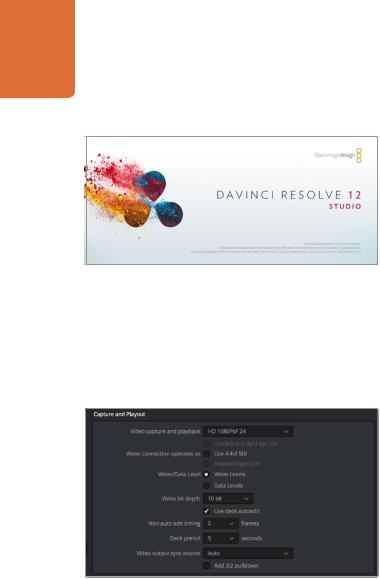
23 DaVinci Resolve
DaVinci Resolve.
Step 3. Select your format from the 'video capture and playback' menu.
Live Grading with DaVinci Resolve
Desktop Video 10 allows simultaneous capture and playback on Blackmagic Design 4K hardware. This is great for users who want to use the live grading feature within DaVinci Resolve, as it means you don’t require two separate devices for input and output.
When using live grading on-set, simply connect the output of the camera to the input of your Blackmagic Design hardware. Then connect the hardware's output to an on-set monitor for grading evaluation and viewing.
Setting Up
Step 1. Launch DaVinci Resolve. From the preferences menu, select the 'video I/O and GPU' tab and select your hardware from the 'for Resolve Live use' option. Save your preferences and restart DaVinci Resolve to apply your changes.
Step 2. Start a project and from within the 'project settings' window, set the resolution and frame rate to match your camera.
Step 3. In the 'project settings' window, go to the 'capture and playback' tab and select your desired format from the 'video capture and playback' menu.
Step 4. Go to the 'edit' page and select file>new timeline.
Step 5. From the 'color' page, select color>Resolve Live. You should now see live video within the viewer and a bright red 'Resolve Live' button will appear above the video.
Using Resolve Live
Step 1. In Resolve Live mode, the 'freeze' button (snowflake icon) freezes the current incoming video frame, so you can grade it without being distracted by motion occurring during the shoot. When you’ve made the adjustment, you can unfreeze playback in preparation for grabbing a snapshot.
Step 2. Once you’re happy with a grade, clicking the 'snapshot' button (camera icon) saves a snapshot of the current still in the viewer, the incoming timecode value, and your grade into the timeline. Snapshots are simply one-frame clips.
Please refer to the DaVinci Resolve manual for more information on Resolve Live.
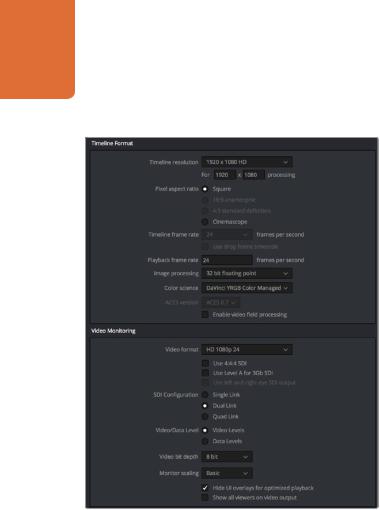
24 DaVinci Resolve
Use the 'project settings' window to set your timeline format and video monitoring options.
Editing with DaVinci Resolve
Blackmagic DaVinci Resolve features an editor friendly interface with all the tools to edit and finish projects. Whether you use the mouse to drag and drop clips, or your keyboard for precision editing, DaVinci Resolve is easy to learn and features all of the functionality professional editors require.
Setting Up
Step 1. Launch DaVinci Resolve. From the 'preferences' menu, select the 'video I/O and GPU' tab and select your Blackmagic Design hardware from the 'for capture and playback use' option. Save your preferences and restart DaVinci Resolve to apply your changes.
Step 2. Load a project, and from within the 'project settings' window, set your 'timeline resolution', 'timeline frame rate' and 'playback frame rate'.
Step 3. Under the 'video monitoring' section, set your 'video format'. This is the format that will be used for the output from your Blackmagic Design hardware.
Step 4. Click the 'save' button to save the changes and close the project settings window.
Editing
Step 1. Use the browser on the 'media' page to load your clips into the media pool.
Step 2. On the 'edit' page, select file>new timeline, name your timeline and click the "create new timeline" button.
Step 3. On the 'edit' page, drag a clip from the media pool to the source viewer.
Step 4. You can set the in and out points in source clips by using the I and O keys.
Step 5. To edit the clip into the timeline, simply drag and drop the clip from the source viewer into the timeline.
Refer to the Blackmagic DaVinci Resolve manual for more detailed information on how to edit with DaVinci Resolve.
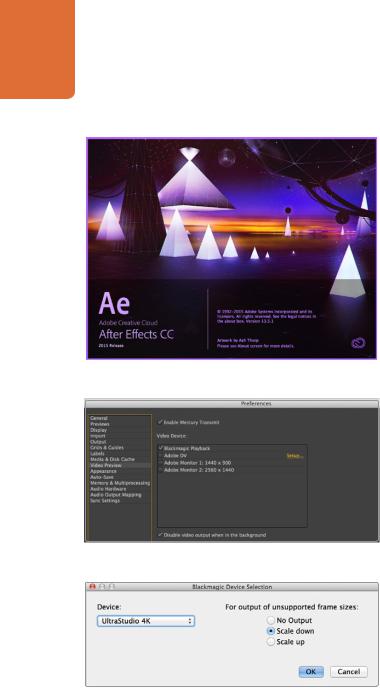
25 Using your Favorite 3rd Party Software
After Effects CC (2015).
'Video preview' preferences.
Select an option to output unsupported frame sizes.
Adobe After Effects CC
How to Preview Video
To display your composition in real-time through your Blackmagic Design hardware, go to preferences > video preview. 'Mercury transmit' must be enabled in order to use your Blackmagic Design hardware with After Effects CC. Under 'video devices', select Blackmagic Playback. You can now use a broadcast monitor to view your After Effects compositions in the correct video colorspace.
If you work with unsupported or non-standard frame sizes, these can also be correctly outputted by your Blackmagic Design hardware. Go to preferences > video preview and click the 'setup' button next to ‘Blackmagic playback'. The 'Blackmagic device selection' window will appear. You can scale your image up or down to the next closest video standard supported by your hardware. For example, if you are using UltraStudio 4K and your After Effects composition is set to a resolution of 2048 x 1152, scaling down will output DCI 2K, scaling up will output Ultra HD.
Rendering
When you have completed your composition, you can render a DPX image sequence or any of the following codecs:
QuickTime codecs on Mac OS X |
|
Blackmagic RGB 10 bit (uncompressed) |
Apple Photo - JPEG (compressed) |
Apple Uncompressed YUV 10 bit 4:2:2 |
Apple DV - NTSC (compressed) |
Apple Uncompressed YUV 8 bit 4:2:2 |
Apple DV - PAL (compressed) |
Other codecs including ProRes and DVCPRO HD will be available if you have Final Cut Pro installed.
AVI codecs on Windows |
|
Blackmagic 10 bit 4:4:4 (uncompressed) |
Blackmagic SD 8 bit 4:2:2 |
Blackmagic 10 bit 4:2:2 (uncompressed) |
(uncompressed) |
Blackmagic HD 8 bit 4:2:2 (uncompressed) |
Blackmagic 8 bit MJPEG (compressed) |
Other codecs including DVCPRO HD and DVCPRO50 will be available if you have Premiere Pro CC installed.
QuickTime codecs on Windows |
|
Blackmagic RGB 10 bit (uncompressed) |
Apple Photo-JPEG (compressed) |
Blackmagic 10 bit (uncompressed) |
Apple DV - NTSC (compressed) |
Blackmagic 8 bit (uncompressed) |
Apple DV - PAL (compressed) |

26 Using your Favorite 3rd Party Software
Adobe Photoshop CC
How to Import and Export Video Frames
Import an image into Photoshop CC
Step 1. Select file > import > Blackmagic image import.
Step 2. Select the 'video input format' and the 'image bit depth' and then click 'import image'.
Export an image from Photoshop CC
Step 1. Select file > export > Blackmagic image export.
Step 2. Select 'video output format' and then click 'export image'.
Photoshop CC (2015).
Once you have set the 'import' or 'export' options, subsequent imports and exports will not display the settings window. However, you can still change your settings, by holding the Option [Mac] or Ctrl [Win] key, when selecting import or export.
Import image.
Export image.

27 Using your Favorite 3rd Party Software
Adobe Premiere Pro CC
Setting Up a Blackmagic Design Project
Step 1. Create a 'new project' and set the desired 'location' and 'name' for your project.
Step 2. |
Click on the 'scratch disks' tab to set the locations for your captured video, captured audio, |
|
video previews and audio previews. |
Step 3. |
If your graphics card is supported by Premiere Pro CC's Mercury Playback Engine, the |
|
renderer option will be available and you should switch it to Mercury Playback Engine |
|
GPU acceleration. |
Step 4. |
Set the Capture Format to Blackmagic capture and click 'settings' [Mac] or 'properties' |
|
[Win] to set the video standard and video format. Click OK and your project will open. |
Step 5. |
To create a new sequence, click file > new > sequence. Select the desired Blackmagic |
Premiere Pro CC (2015). |
preset, give the sequence a name and then click OK. |
Device Control
Many Blackmagic Design capture and playback models feature RS-422 device control for controlling decks. Click preferences > device control, and check that Blackmagic device control has been selected from the 'devices' menu.
Playback
To ensure your video and audio plays back through your Blackmagic Design device, check your 'playback settings' by going to preferences > playback. Select 'Blackmagic playback' in both the 'audio device' and 'video device' menus.
If you work with unsupported or non-standard frame sizes, these can also be correctly outputted from your Blackmagic Design hardware. Go to preferences > playback, and click the 'setup' button next to ‘Blackmagic playback'. The 'Blackmagic device selection' window will appear. You can scale your
image up or down to the next closest video standard supported by your hardware. For example, if New Sequence you are using UltraStudio 4K and your Premiere sequence is set to a resolution of 3996 x 2160, scaling
down will output Ultra HD, scaling up will output DCI 4K.
Select an option to output unsupported frame sizes.
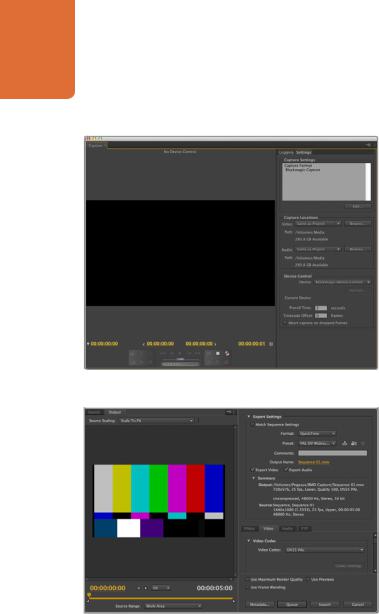
28 Using your Favorite 3rd Party Software
Capture.
Export to tape.
Capture
To capture choose: File > capture [F5]
To immediately capture, or to capture from a non-controllable device, click the red record button [G].
If you wish to log the clip using RS-422 deck control, enter the desired in and out points using either the 'set in' and 'set out' buttons, or manually by typing the timecode and clicking 'log clip'. The empty clip will now appear in the 'project' window. Repeat this until you have logged all of the clips you wish to batch capture. Then choose: File > batch capture [F6]. To set handles on the clips, enable the option to capture with handles and type the number of additional frames you require at the start and end of each clip.
Export to Tape
If you want to export your edit to an external deck, you can do so using Premiere’s ‘export to tape’ feature. Choose between two export types: insert and assemble. Insert editing requires unbroken timecode over the full length of the project which is to be laid to tape. In assemble mode the tape needs only to be “blacked” until a point just beyond the start time of the project. As assemble editing erases the tape ahead of the record heads, it should not be used where other projects already exist on the tape after the out point of your edit.
To export to tape via RS-422 deck control:
Step 1. Make sure your Blackmagic Desktop Video device is NOT set as the default audio device for your computer’s system audio.
On Mac, go to system preferences and select 'built-in mic' as the input and 'internal speakers' as the output.
On Windows, go to the task bar and right click on the audio ’speaker’ icon to open the sound settings. Click on the ‘playback’ tab and set your PC to use the on board sound hardware or a sound output device other than your Blackmagic Design hardware. Click on the ‘recording’ tab and set the computer to use a recording device other than your Blackmagic Design hardware.
Step 2. Go to Adobe Premiere ‘preferences > audio hardware’ and set ‘Adobe desktop audio’ to ‘built-in output’ using the dropdown menu. Set ‘output mapping’ to ‘Adobe desktop audio’ and ‘playback > audio device’ to ‘Blackmagic playback’. Ensure ‘Blackmagic playback’ is also selected under the ‘video device’ settings.

29 Using your Favorite 3rd Party Software
Step 3. Open Premiere’s ‘edit to tape’ window by clicking File > export > tape (serial device). Click on ‘recorder settings’, select Blackmagic capture > settings > format and set the ‘capture format’ to match your desired output format. If the capture format does not match the output format, it can cause confusion for the deck during preroll and audio might not be exported.
Step 4. Now set your desired export type by selecting ‘assemble’, or ‘insert’, enter the desired in point and click OK on a Mac, or ‘export’ on Windows.
When editing to tape, the software waits at the first frame of your project for the deck to drop into record at the predetermined timecode. Should you find that either the first frame of your program is repeated or lost during the edit to tape procedure, you will need to adjust the ‘playback > video device > offset’ setting to bring the deck and computer in sync. You should only need to do this once with any combination of deck and computer and the correct setting will be retained.
Your sound settings only need to be changed for the ‘export to tape’ feature. Don’t forget to go back into your computer sound settings and restore them to their earlier state or your workflow may be affected.
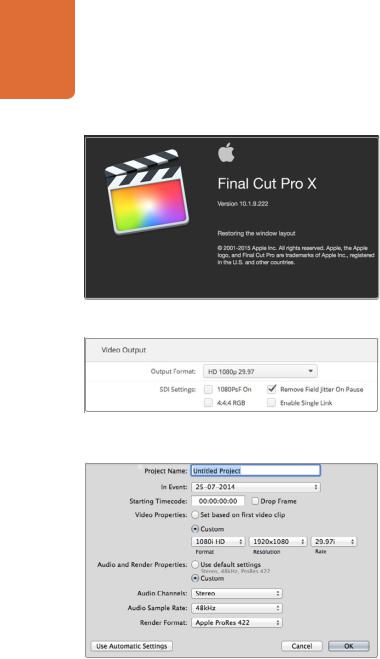
30 Using your Favorite 3rd Party Software
Final Cut Pro X
You can use the broadcast monitoring feature of Final Cut Pro X 10.0.4 and later to output your video through Blackmagic Design video hardware. You can also use two computer monitors for the Final Cut Pro X interface.
Setting Up Final Cut Pro X
Final Cut Pro X.
Step 2. Set the 'output format' to match your Final Cut Pro X project format.
Step 6. Set the 'audio and render properties' to 'custom'.
Step 1. Ensure you are running Final Cut Pro X 10.0.4 or later with the latest version of Mac OS X Mavericks or Yosemite.
Step 2. Open Blackmagic Desktop Video Utility. Go to 'output format' and then set the same format that you will use in your Final Cut Pro X project, e.g. HD 1080p29.97. The format should be the same as the video format of your clips.
Step 3. Launch Final Cut Pro X and create a new project.
Step 4. Type a name and choose a location for the new project.
Step 5. Set the 'video properties' to 'custom' and then set the format, resolution and frame rate to match the output format set in Blackmagic Desktop Video Utility.
Step 6. Set the 'audio and render properties' to 'custom'. Set the audio channels to stereo or you can choose 'surround' for 6 audio channels. Set the audio sample rate to the television rate of 48kHz. Set the render format to the same format as your video clips. Final Cut Pro X defaults to using ProRes compression but you can switch this to Uncompressed 10-bit 4:2:2 for an uncompressed workflow. Click OK to complete the creation of your new project.
Step 7. Go to the Final Cut Pro menu, choose 'preferences' and then click the 'playback' tab. Ensure the 'A/V output' menu has selected 'Blackmagic' and the same video standard as your project and then close the preferences.
Step 8. Go to the 'window' menu and select 'A/V output' to enable video output via your Blackmagic Design video hardware.
If you wish to monitor audio via your Blackmagic Design video hardware, open the 'system preferences', click the 'sound' icon, click the 'output' tab and then select 'Blackmagic Audio' for the sound output.
Playback
Step 1. Import some clips in to your new project.
Step 2. You can now use the Final Cut Pro X timeline on your computer monitor and view the video preview on the monitor or TV connected to the output of your Blackmagic Design video hardware.
